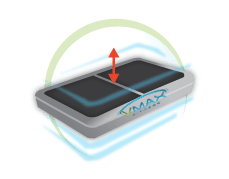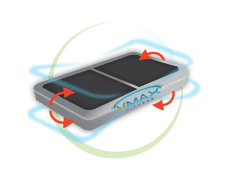VIBRATION TYPES
In whole body vibration (WBV) technology, the entire body is exposed to vibration, as opposed to local vibration (Biomechanical Stimulation, BMS), where an isolated muscle or muscle group is stimulated by the use of a vibration device. Whole body vibration is implemented through the use of a vibrating platform on which static poses are held or dynamic exercises can be performed depending on the type and force of the machine. The vibrations generated by motors underneath the platform are transmitted to the person on the machine. There are currently 2 vibration technologies that are widely available for use — oscillation and triplanar vibration.

TRIPLANAR / SPIRAL VIBRATION TECHNOLOGY
The vibrating machine’s platform is mainly doing the same motion, respectively: both feet are moved upwards or downwards at the same time. The vibration direction is vertical, lineal, or upward, eliciting a strong stretch-reflex contraction in muscle fibers targeted by the positions of training program.
OSCILLATION OR PIVOTAL VIBRATION TECHNOLOGY
Side alternating (pivotal) vibration machines operate like a see-saw and mimic the human gait where one foot is always moving upwards and the other one downwards. This (teeter-totter movement) is used for physiotherapy at lower speeds and exercise workouts at higher speeds.

The oscillation or pivotal vibration offer larger amplitude of oscillation at lower frequencies whereas the lineal vibration offers lower amplitudes but higher frequencies. Both types of vibration systems are capable of delivering health benefits. But because each person’s reaction to vibration motion is different, it is important to try both systems to determine the ideal setup for your body.
The V-Max Trio, Q5, and Pro Duo whole body vibration machines removes the confusion by combining both the lineal and oscillation vibration motions in one free standing unit. Because of the dual motor, 3 vibration motion design, these machines allows you to rapidly achieve results in as little as 10 minutes a day.

